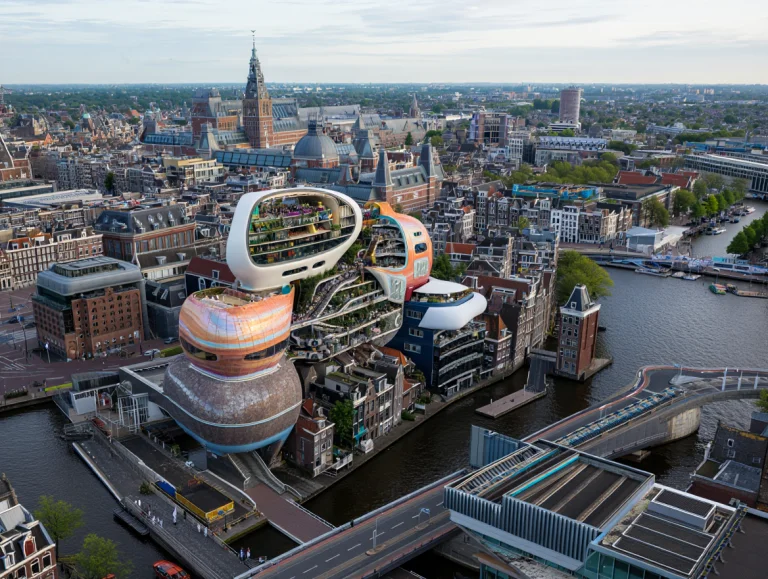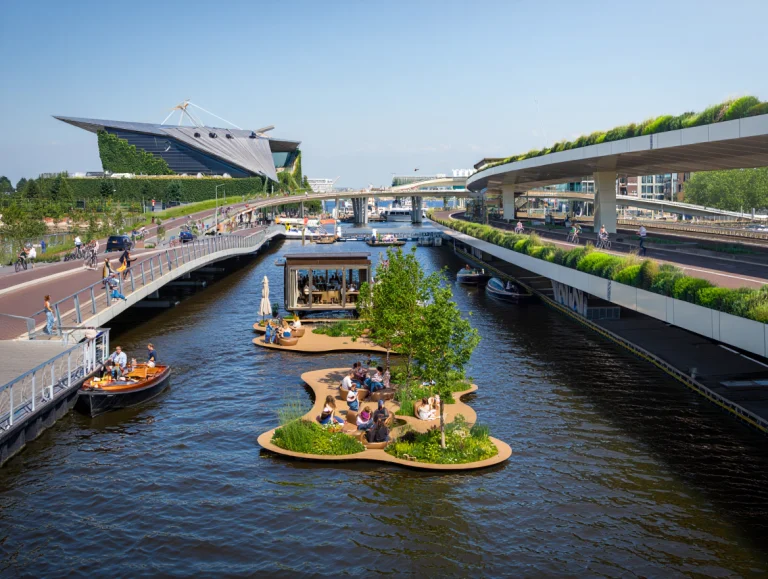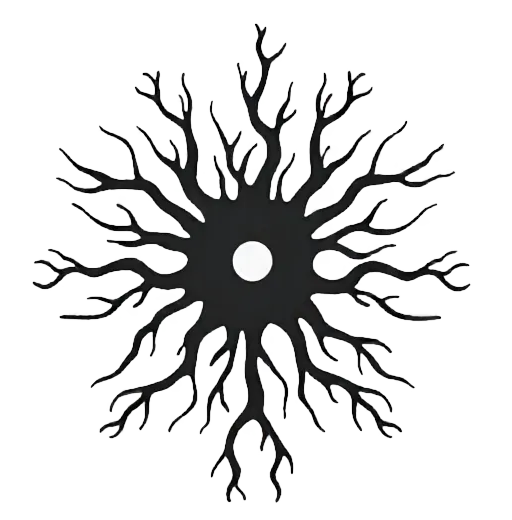
Amsterdam 2075: A Living Tapestry of Everyday Futures
In the heart of 21st-century Europe, a bold experiment in urban life is unfolding — not in Silicon Valley or a new megacity, but in Amsterdam. Long admired for its canals, human-scale neighborhoods, and design-forward pragmatism, the city has taken a visionary leap into the future. Welcome to Amsterdam 2075, a place where architecture breathes, neighborhoods think, and every home is a reflection of its occupant.
This isn’t just a smart city — it’s a social city, a vibrant reimagining of what urbanism can be. At the core of this transformation lies an unexpected inspiration: Team X, the mid-20th-century architectural collective that rebelled against rigid modernism and championed human needs, context, and community. Now, more than a century later, their values have found fertile ground in a city that has turned their ideas into living systems.
Aerial Symphonies of Structure and Story From above, Amsterdam 2075 appears as an intricately woven tapestry: canals still spiral through the city like veins, but the built environment has evolved into a patchwork of organic forms, floating platforms, and modular towers, each one different. Landmarks such as the Rijksmuseum and Westerkerk remain proudly rooted in the city’s silhouette — not relics, but active participants in a new urban dialogue.
The skyline is now defined by diversity. There are no repeating apartment blocks here. Each living unit is uniquely shaped and clad in materials ranging from reclaimed Dutch brick to soft ceramic skins or adaptive glass surfaces that filter sunlight and react to user preferences. Amsterdam has become a city of individuals bound by collective care — a living organism reflecting the values of its people.
The Rise of the “Social Cell” Gone are the zoning maps and fixed-use blocks of the 20th century. In their place: Social Cells — hyper-local neighborhood clusters that function as small democracies. Powered by real-time data and AI urban stewards, these cells constantly adapt: opening communal kitchens during holidays, reshaping public courtyards for art shows or quiet meditation, or even dissolving into green corridors when no longer needed.
Every month, residents participate in Local Design Forums, where decisions about their immediate environment are made collaboratively. Here, Team X’s dream of participatory, context-aware urbanism becomes reality — not through top-down policy, but through bottom-up interaction and digital tools that amplify, not replace, human voices.
From “As Found” to “As Traced” Where Team X embraced the raw honesty of the “as found,” Amsterdam 2075 works with the “as traced” — a deep integration of behavioral, cultural, and emotional data into architectural expression. Street corners transform depending on how people use them: a quiet bench for reflection in the morning becomes a vibrant café space by dusk. Each intervention is temporary, precise, and deeply rooted in human ritual.
Meanwhile, history is not erased but layered into daily experience. Buildings integrate preserved textures and materials into futuristic forms. Augmented overlays let passersby view former cityscapes, listen to recorded memories, or activate heritage stories embedded in walls. The past breathes through the present.
Floating Commons and Vertical Gardens As sea levels rise and land becomes scarce, Amsterdam has embraced its relationship with water like never before. Entire neighborhoods now float: platforms covered in greenery house public baths, markets, schools, and theaters. Elevated bike highways connect rooftops, while autonomous water taxis glide silently through widened canals.
These are not sci-fi utopias — they are functional, beloved parts of city life, where mobility is human-centered, and sustainability is woven into every decision.
An Optimistic Blueprint Amsterdam 2075 offers a refreshing counterpoint to the dominant narratives of sterile, AI-run smart cities. It’s not about efficiency alone — it’s about meaning, participation, and beauty. It’s a city that feels lived in, loved, and in motion.
In many ways, it answers the open questions left by Team X: What does architecture look like when it is shaped not by top-down ideology, but by the messy richness of life? What happens when we build not for control, but for coexistence?
The result is more than just a futuristic city — it’s a living design fiction come true. One that redefines how we live together, how we remember, and how we change — not as isolated users, but as connected citizens of space, time, and place.
speculatives
Analyse des Konzepts anhand von Designfiktion Kritierien.
- noch kein Designfiktion Qualitätscheck vorhanden -
realistics
Reality Check anhand aktueller Studien und Forschung.
Theoretische Fundierung
Das Konzept baut auf Team X-Ideen auf, die partizipative Stadtplanung und Kontextsensibilität betonen. Aktuelle Forschung zu „Tactical Urbanism“ und adaptiven Systemen stützt den Ansatz, doch die Übertragung auf eine komplett datengesteuerte Stadt wirft Fragen nach Theorie-Praxis-Lücken auf. Wie wird kollektive Entscheidungsfindung bei divergierenden Interessen skalierbar?
Praktische Umsetzbarkeit
Technisch sind adaptive Materialien und KI-Steuerung bereits im Entstehen, aber die flächendeckende Integration erfordert ungeklärte Infrastruktursprünge. Schwimmende Quartiere existieren prototypisch (z. B. Floating Pavilion Rotterdam), doch Skalierung und Wartungskosten bleiben riskant. Wer trägt die Verantwortung bei Systemausfällen?
Gesellschaftliche Implikationen
Der Fokus auf Hyperlokalismus könnte soziale Fragmentierung verstärken – nicht alle Bürger*innen haben Kapazität für monatliche Design-Foren. Studien zeigen, dass partizipative Prozesse oft privilegierte Gruppen begünstigen. Wie wird Inklusion für marginalisierte Communities garantiert?
Ethische Spannungsfelder
„As Traced“-Architektur basiert auf massiver Datenerfassung. Trotz betonter Humanzentrierung droht Überwachung durch verhaltensresponsive Räume. Aktuelle Debatten zu Privatsphäre (z. B. GDPR) kollidieren mit dem Konzept. Wer kontrolliert die Algorithmen hinter den „AI Urban Stewards“?
Gestalterische Konsequenzen
Die Abkehr von standardisierten Wohnformen erhöht individuelle Ausdrucksfähigkeit, aber auch Baukosten. Materialinnovationen wie adaptive Keramiken sind noch nicht marktreif. Kann ästhetische Vielfalt ohne soziale Ungleichheit („Design-Gentrifizierung“) gelingen?
Transformationale Potenziale
Progressiv ist die Verbindung von Klimaresilienz (schwimmende Quartiere) und sozialer Innovation. Das Konzept nutzt Digitalisierung als Werkzeug für Gemeinschaft – ein Gegenentwurf zu Tech-Konzern-dominierten Smart Cities. Könnte ein Modell für postkapitalistische Stadtentwicklung sein, wenn Eigentumsfragen geklärt werden.
Akzeptanzbedingungen
Erfolg hängt von kultureller Verankerung ab: Amsterdams Traditionen wie Fahrradkultur und Gemeinschaftsorientierung begünstigen Adoption. Doch ohne klare Regulierung (z. B. Datenhoheit) droht Scheitern an Misstrauen. Lässt sich das Modell auf weniger kooperative Städte übertragen?
👾
ᏰᏒᏋᏋᎴᏋᏒ LLM is working now...
pragmatics
Relektiert die Kernideen des Konzepts und generiert vereinfachte Varianten - die mit niederschwelligen Methoden und Materialien umsetzbar sind.
ethics
Reflektiert die ethische Perspektive auf das Projekt - sucht und hinterfragt kritische blinde Flecken im Konzept und entwickelt erbauliche loesungsorientierte Fragestellungen.
intrinsics
Reflektiert zugrundeliegende intrinsische Motivation des Projektes - untersucht diese kritisch und reflektiert mit erbaulichen Fragestellungen.
network
Zeigt Verbindungen oder interessante Überschneidungen zu anderen Konzepten innerhalb dieser BREEDER Instanz.
null
Loaded php.ini: /var/www/vhosts/system/designfiction.turboflip.de/etc/php.ini
upload_max_filesize: 45M
post_max_size: 48M






